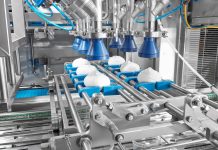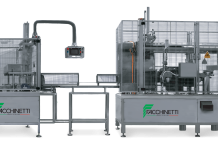 The sheep milk and cow milk differs for some chemical-physical and microbiological characteristics that influence the cheese-making process, particularly the fat and casein contents are more than twice in the sheep milk. The sheep milk is characterized by a remarkable composition variability (Ledda, 1992) due to: genetics, stage of lactation and, to a lesser extent, food and stall housing conditions. Sheep milk is porcelain white and clearer than cow’s, due to less presence of carotene; it has also higher viscosity due to more solids. The sheep’s milk requires more rennet but results with more curds as it is richer in fat and protein content than the cow milk. Its acidity is around 4.0 to 4.5°SH/50.
The sheep milk and cow milk differs for some chemical-physical and microbiological characteristics that influence the cheese-making process, particularly the fat and casein contents are more than twice in the sheep milk. The sheep milk is characterized by a remarkable composition variability (Ledda, 1992) due to: genetics, stage of lactation and, to a lesser extent, food and stall housing conditions. Sheep milk is porcelain white and clearer than cow’s, due to less presence of carotene; it has also higher viscosity due to more solids. The sheep’s milk requires more rennet but results with more curds as it is richer in fat and protein content than the cow milk. Its acidity is around 4.0 to 4.5°SH/50.
The fat
The fat globules have an average diameter relatively smaller than in cow’s milk (Battistotti, 1992), negatively the protective membrane is weaker and can be easily torn by mechanical action, as a result fat can easily turn into rancid. Fats are made for 98% of triglycerides, for 0.8% of phospholipids and for minor amounts of free fatty acids. The prevalent fatty acids are palmitic and oleic (25% and 20%); the presence of medium-chain acids – short as capric and caprylic is responsible of the characteristic castor oil flavour of the sheep cheese. The fat is the component that undergoes the largest changes during lactation; these variations have a significant influence on the behaviour of dairy milk and particularly on the final fat content of cheese. Yields are higher than with cow’s milk.
The Proteins
The content of protein is subject to variations during the lactation, but to a lesser extent than fat. With the progress of lactation, the milk tends to enrich itself of casein and soluble proteins, while there is steadily decrease of non-protein nitrogen. Through the analysis of the composition results that the casein fractions S1 and S2 are lower in the sheep milk than in the cow’s, while the beta casein is higher in sheep milk; these differences alter the milk behaviour when it is heated in the vats (Resmini, 1978), it coagulates about 1.5 times quicker than cow’s milk and curd firmness, in the same laps of time, is about double. The whey proteins (lactoglobulin, lactalbumin and serum albumin) are present in higher percentage than the goat and the cow’s milk, these proteins have a main role in the ricotta making process.
The manufacture of all sheep cheese is quite similar but it’s matter of small changes in the procedures for leading to products that are completely different one to the other. Typically, the final molds are from 1.5 to 12 Kg weight or over, with flat top and bottom and height of 12-15cm, the dough is white or yellowish with pittings, the distinctive spicy flavor and aroma is intense and persistent. Whole sheep’s milk is brought to 36-41 degrees Celsius and inoculated with desirable lactic acid fermenting bacterial culture (Vizzardi and Maffeis, 1990), such as lactic acid bacteria (Lactobacillus helveticus and Streptococcus thermophilus) and propionic acid bacteria. The flora is meant to flavor and acidify the curd by turning milk sugars into lactic acid. Prior of cheese-making, milk can be pasteurized in order to stabilize the total bacterial count. The curdling of the milk starts thanks to the intervention of a protease enzyme (rennet in paste) extracted from the abomasa usually of calves, in this case from the fourth stomach of goat kids or lambs (the dose is about 30 g/q of milk). The time of coagulation depends by the quantity of rennet, temperature and total acidity. It usually takes 45 minutes for the casein to precipitate and to shape a clot capable of releasing the whey and retaining proteins and fat. When the coagulum has attained the proper characteristics it is ready to be cut into as uniformly small cubes or beans; the whey separation is boosted when the curd is cut, this may be enhanced by gentle stirring. In cooked cheeses has to be obtained the size of a grain of corn or rice, thus allowing a significant loss of water, while in soft cheeses at higher moisture content, the curd is to be cut lightly to the size of a walnut or hazelnut. Once broken, the curd is stirred and brought to the temperature of 40-42°C: cooking helps firming the curd particles, expediting whey expulsion and obtaining a compaction of cheesy lumps. After a rest period of a few minutes at the bottom of the vat, the curd is extracted and placed in special molds in plastic or wicker; exerting a certain pressure on the dough the whey in excess is squeezed out. After a few turnings, the wheels are plunged into boiling whey for several minutes, this helps the curd to better drip out, to have a perfect rind closure and to facilitate enrichment of the microflora. Salting process can be both dry or in brine. Dry salt is rubbed on the surface of the block of curd for about 10 days in an environment with a temperature between 10 and 12°C; in brine the curds are left for a period ranging from several hours to days depending on the weight of the forms. Salting has several functions:
- can further accelerate the purging of the moisture;
- helps to avoid the formation of moulds on the surface of the cheese;
- emphasizes the flavor of the cheese (Vizzardi and Maffeis, 1990).
The aging varies from 20 days of Pecorino Toscano to more than 18 months of Canestrato Pugliese. The manner and time of aging probably influences the quality more than other phases of manufacture. Aging and ripening help the product to take the consistency and appearance desired; through a complex chemical process-enzyme, characteristic flavors and aromas of the product are developed. The ripening takes place in natural or refrigerated cells at low temperatures (3-10°C) and high humidity (85-95%). During aging the microorganisms and enzymes that were active in coagulating and now still active in the cheese, contribute to physical and chemical change, throughout all the dwelling, of all the components of the cheese. At the end of aging, it is achieved the complete transformation of the lactose and the formation and consolidation of the outer rind.
The classification of cheese is based on several characteristics: texture (hard, semi hard, soft), processing technique (fresh, soft-cheese, cheese retained in brine, hard and semi hard cheese, pasta filata cheese, blue-veined, yogurt), and duration of ripening. The data relating to fat content is not used as a criteria for the classification of sheep cheese, because all products are made with whole milk.
Fresh
Fresh cheese are obtained by acid or rennet or mixed coagulation and do not undergo any aging process, there are no examples in our country, but are quite popular in France (Battistotti, 1992), while in our country are niche products linked to local traditions, good example are: Felciata Morano Calabro and Paddaccio (Basilicata).
Soft cheeses
The soft table cheese produced in Italy, are both products of industrial dairies or of small-scale dairies bound to rural territory and processing typical milk. In general, these products are called “caciotte”; among the most famous: the PDO “Caciotta Tuscany” and PDO “Casciotta of Urbino”. Another very well known soft cheese is the “Murazzano”, it is produced with pure sheep’s milk or mixed, but with a percentage of sheep’s milk not less than 60% (Delforno, 1981). The Murrazzano cheese is named after the homonymous town near Cuneo.
Cheese retained in brine
These are typical products of the Balkan countries, have a soft texture and compact and are preserved in brine or salted whey. The best known is the Greek feta, made with uncooked whole milk and with grafts of selected cultures of Lactobacillus delbrueckii subsp. bulgaricus and Streptococcus lactis (Battistotti, 1992).
Semi-hard or hard cheese
This category is very broad and there are some of the most representative of Italian productions of pecorino cheese. Among others the DOP (Protected Designation of Origin) Pecorino Romano and Pecorino Toscano. Their area of production is for the Romano: Lazio, Sardina and part of the southern Toscany; for Pecorino Toscano: throughout Tuscany and in some towns in Umbria and Lazio (Battistotti, 1992). Another cheese called “Rigatino” (UIAPROC, 1993) is made of mixed milks, for its production are usually used three parts of cow’s milk and one part of sheep’s milk. Produced in limited quantities, but very appreciated by connoisseurs, is the “Fossa Cheese” which is obtained from sheep or mixed milk that after mid-August, are stored in pits dug in the center of Sogliano the Rubicon (near Forlì) where they complete the aging until the end of November. For last, the caciotta of Monte Mauro of Brisighella (near Ravenna), it’s obtained mainly with sheep’s milk and with smaller quantities of goat and buffalo milk. Buffalo milk makes the product texture very soft even after a long aging period (Acconci et al., 1992).
Pasta filata cheese
They are similar to provolone and mozzarella, they are popular in Greece and in the Balkan countries, but have no equivalent in our country, apart the Scamorza di pecora (scamorza of sheep) produced in Apulia (Battistotti, 1992).
Blue-veined cheese
In Italy does not exist this type of cheese made from sheep milk, but it is well known the French Roquefort, for which it’s used whole milk only. As it’s not heat treated: it is essential the hygienic quality of the raw milk.
Yogurt
Yoghurt from sheep’s milk is a typical product of Greece and is not widespread outside of this area, except for handicraft production, such as Gioddu Sardinian (Battistotti, 1992). The yogurt from sheep’s milk is more compact and with a clot more dense than the vaccine one.
Ricotta
The milk proteins involved in the formation of the ricotta are the whey proteins, almost exclusively globulins and albumins (Battistotti, 1992), present in the sheep’s milk in amounts of about 7 grams per liter. Generally intended for immediate consumption (ricotta), although this product can also undergo a period of aging; technically this product cannot be called cheese.
Caprini Cheese made from goat milk
You should pay attention to the label and to the ingredients used to produce “caprino” cheese as this term can be misunderstood for a similar type produced from cow’s milk that it’s named “caprino vaccino”. The goats are usually breed in areas unsuitable for farming. In recent years, the cows herd has experienced a period of crisis, because of a surplus of product, this has boosted the born of many herds of goats. Goat milk is excellent and the cheese quality is high, it tastes very delicate. The downside is that the fresh cheese is not available during the winter months, when the goats are in dry-off. Like sheep’s also the goat’s milk differs from cow’s milk for some chemical-physical characteristics: the percentage of fat and casein is lower, while it is very rich in whey-proteins. Another difference is in the composition of the fat globules structure, very small. In addition, goat milk contains higher percentages of some fatty acids such as caproic acid, capric, caprylic with strong sensitivity to the lipolysis, for this the cheese are characterized by a strong smell. Also like sheep’s milk, it is devoid of carotene, as result its products are of a particular whiteness. The goat’s milk, due to the low casein content and soluble salts of calcium, tends to give inconsistent and soft cheeses. The goat cheese fall mainly into the categories of small-sized soft cheeses, The manufacturing technologies can be divided into two groups: lactic coagulation, obtained by acid coagulation, and rennet coagulation. In slow coagulation the use of liquid rennet is minimal, about 2 ml/hl, it is added a few hours after the start of acidification. The coagulation lasts for several hours, at the end of coagulation the final acidity of the coagulum is close to 2.2 to 2.4°SH/50.





